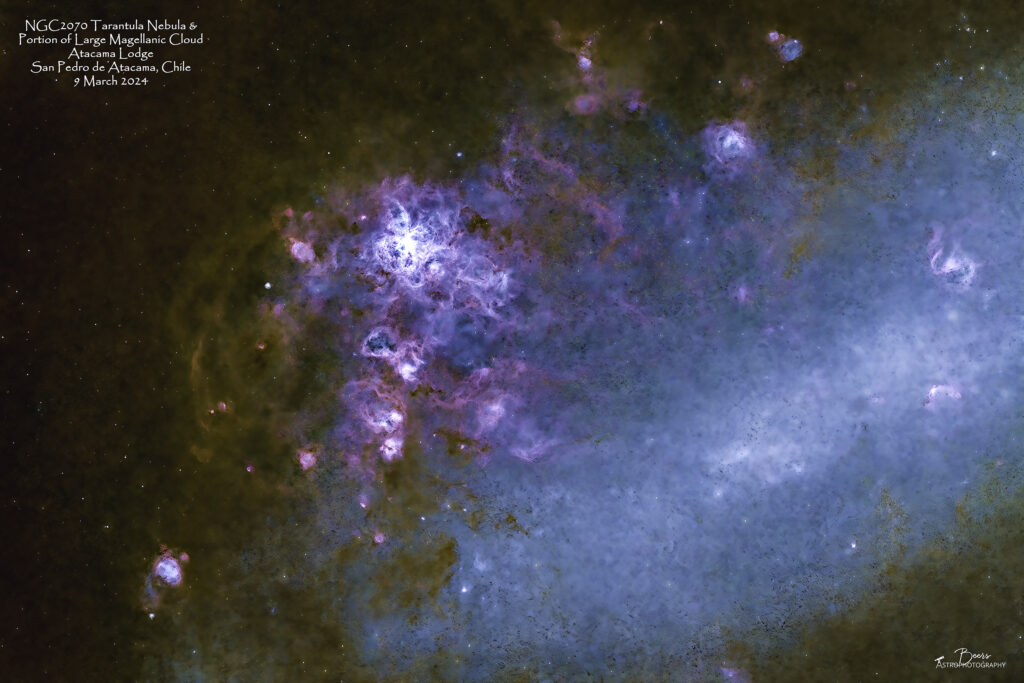
Fun facts
NGC 2070 (also known as Caldwell 103) is a large open cluster and candidate super star cluster forming the heart of the bright region in the center-south-east of the Large Magellanic Cloud. It is at the center of the Tarantula Nebula and produces most of the energy that makes the latter’s gas and dust visible. Its central condensation is the star cluster R136, one of the most energetic star clusters known. Among its stars are many of great dimension, including the second most massive star known, R136a1, at 215 solar mass (M☉) and 6.16 million solar luminosity (L☉).
Note: The solar mass (M☉) is a standard unit of mass in astronomy, equal to approximately 2×1030 kg. It is approximately equal to the mass of the Sun. The solar luminosity (L☉) is a unit of radiant flux (power emitted in the form of photons) conventionally used by astronomers to measure the luminosity of stars, galaxies and other celestial objects in terms of the output of the Sun. One nominal solar luminosity is defined by the International Astronomical Union to be 3.828×1026 W
Distance: 157,000 light years
Apparent Magnitude: 7.25
Apparent Dimensions: 3.5′ x3.5′
Constellation: Dorado
Designations: Caldwell 103, PKS 0539-69
{ From: https://en.wikipedia.org/wiki/IC_2944 }
And a small portion of the Large Magellanic Cloud (LMC)…a spiral satellite galaxy of the Milky Way. At a distance of around 50 kiloparsecs (163,000 light-years), the LMC is the second- or third-closest galaxy to the Milky Way, after the Sagittarius Dwarf Spheroidal (c. 16 kiloparsecs (52,000 light-years) away) and the possible dwarf irregular galaxy called the Canis Major Overdensity. Based on the D25 isophote at the B-band (445 nm wavelength of light), the Large Magellanic Cloud is about 9.86 kiloparsecs (32,200 light-years) across. It is roughly one-hundredth the mass of the Milky Way and is the fourth-largest galaxy in the Local Group, after the Andromeda Galaxy (M31), the Milky Way, and the Triangulum Galaxy (M33).
The LMC is classified as a Magellanic spiral. It contains a stellar bar that is geometrically off center, suggesting that it was a barred dwarf spiral galaxy before its spiral arms were disrupted, likely by tidal interactions from the Small Magellanic Cloud (SMC) and the Milky Way’s gravity.
With a declination of about −70°, the LMC is visible as a faint “cloud” from the southern hemisphere of the Earth and from as far north as 20° N. It straddles the constellations Dorado and Mensa and has an apparent length of about 10° to the naked eye, 20 times the Moon’s diameter, from dark sites away from light pollution.
The LMC is predicted to merge with the Milky Way in approximately 2.4 billion years.
Distance: 163 kly (49.97 kpc)
Apparent magnitude: 0.13
Apparent dimensions: 10.75° x 9.17°
Constellation: Dorado/Mensa
Other designations: LMC, ESO 56- G 115, PGC 17223, Nubecula Major
{ From: https://en.wikipedia.org/wiki/Large_Magellanic_Cloud }
Capture & Processing Notes
Motivated by Alain Maury’s star tour a few night before, where we were treated to a viewing of the Tarantula Nebula through his 45″ telescope – I spent night #4 of the Atacama Desert trip capturing two targets – 52x5min on NGC2070 Tarantula Nebula from dark until it set at about 0200. Then, I took advantage of the rest of the darkness by gathering 53x5min on NGC6188 Fighting Dragons of Ara from 0200 until 0640, the end of astronomical twilight.
I was still struggling with getting the park position correct for the Southern Hemisphere. Had slewed to 0, 90 before shutting down Night#3 imaging so started in that position for the focusing star sequence. Once I completed it, the mount returned to home at 0, 270. I realized that I hadn’t focused the autoguider camera, so I ran the focus star sequence again starting from 0, 270 – it worked fine. So, that made me believe that maybe the fact that the mount is parked pointing to the west when it’s supposed to be pointing to the east really doesn’t matter. I shut everything down to start the NGC2070 sequence from the 0, 270 starting position. Immediately as the slew began, I discovered – it DOES matter! When the mount began to slew, it rotated counter-clockwise in RA wrapping the cabling precariously around the telescope and ended up pointing to the ground! At that point, I decided to end my battle with the “correct” parking position and just adjust to 0,90 at the end of each sequence for the rest of this trip.
Sequence Plan:
- Sequence plan: Gain: 158, Temp: -0°C, offset=30; Captured 53x5min; Total exposure time: 265 minutes, 4:25 hours.
- Captured: 9 March 2024 (9Mar2024, 2108CDT – 10Mar2024, 0144CDT);
- Shooting location: Atacama Lodge, San Pedro de Atacama, Chile
Processing summary: Captured with SGP. Stacked in APP. Star removal with Starnet++. Processed in LR/PS
Equipment
All equipment controlled by HP Probook (DSO CTRL 1) Windows 10 laptop running Sequence Generator Pro v4.3.0.1305.
- Polar alignment: QHYCCD camera (controlled by Polemaster for polar alignment)
- Imaging: (Southern Cross) Askar FRA600 on Rainbow Astro RC-135E, ZWO ASI2400MC#1 camera
- Autofocuser: ZWO EAF ( Electronic Automatic Focuser)
- Mount: Rainbow Astro RST-135E (controlled by iHubo ASCOM driver)
- Autoguiding: Orion 60mm Multi-Use Guide Scope with Orion StarShoot AutoGuider Pro Mono Astrophotography Camera (controlled by PHD2)
